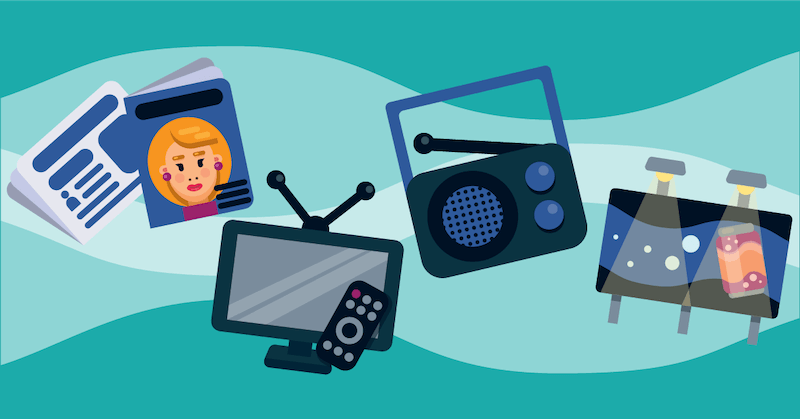4 Traditional advertising benefits

Traditional advertising media has been around for so long, it’s easy to write it off as slow and old-fashioned. Why would you put up a billboard when you can make a Facebook ad in a few minutes, or shell out for a broadcast TV spot when you can put your money into YouTube pre-roll? Advertising is about turning heads, and nothing turns heads like the latest and greatest…right?
Not so fast. We’d never trash talk digital advertising – it is, after all, much of what we do – but traditional advertising is not quite the dinosaur it’s been made out to be. (Unless, of course, we’re talking about a world in which the dinosaurs never went extinct and are still out there, being awesome and turning heads.) Sure, digital advertising has many benefits when it comes to tracking and targeting…but if you’re writing off traditional advertising as obsolete, you might be doing your brand a huge disservice.
Reports of the death of traditional advertising have been greatly exaggerated. Let’s dig into the evidence by looking at four traditional media benefits.
Traditional advertising benefit #1: it’s more popular than you might think

Conventional wisdom might tell you that people aren’t reading magazines or watching broadcast TV like they used to. While that may be conventional, it’s not exactly wisdom. According to Nielsen, streaming accounts for only 26% of TV watching – meaning that traditional broadcast TV, with ads and all, accounts for the other 74%. The figures for print are perhaps even stronger. MNI reports that magazine readership is consistent across generations, with Boomers, Gen Xers, and Millennials all averaging roughly 9 magazines per month.
We could spout facts and figures all day, but here are just a few more highlights for you to consider:
- Nielsen reports that 85% of consumers who saw a billboard noticed the ad message, and 40% of consumers searched for a brand online after seeing an OOH ad.
- A whopping 89% of Americans (age 12 or older) listened to terrestrial radio in a given week – a figure that has stayed steady over the past decade.
- 90% of US adults watch television, with the average clocking in at 25 hours per week.
The numbers are clear: one of traditional media’s benefits is absolutely massive reach. When you consider that many forms of traditional advertising are not skippable in the way many digital ads are, that reach starts to look even more impressive.
Traditional advertising benefit #2: it has gravitas

The benefit of social media advertising is that you don’t need a lot of money or experience to get a campaign up and running. The downside of social media advertising is that…well, you don’t need a lot of money or experience to get a campaign up and running. Anyone with a Facebook account can fancy themself an expert and start pouring money into an ad campaign. Now, a successful digital campaign is another matter entirely…but the fact remains that any person or brand can put up a social media ad (sometimes of questionable quality) in a way that they can’t, say, put up a billboard or get a radio spot.
The barrier to entry is much lower than that of traditional media, and as a result, traditional media has developed an air of trust and respectability. And it’s not unearned. Imagine a world in which Coca-Cola had only ever advertised on Facebook, versus the world in which Coca-Cola gets a primetime ad spot in the Super Bowl. Which Coca-Cola seems more impressive?
Traditional advertising benefit #3: it keeps your brand top of mind

Actually, you don’t need to imagine: just look at the case of Coke’s biggest rival. A few years back, Pepsi made a radical shift away from traditional media and made a heavy social media push instead. The result? Without traditional media to keep them top of mind, Pepsi lost market share and was back on broadcast TV screens and billboards everywhere in short order (tail between their legs, presumably). The reasons for their failure are varied and deserving of their own case study, but it’s telling that they made a quick return to traditional media, and haven’t left since.
The thing about traditional media is that it works even when it doesn’t lead to an instant conversion. Ask practically anyone in the world, and they’ll tell you of course they’ve heard of Pepsi, what a silly question! But without the steady drumbeat of broadcast TV ads and billboards to remind the world of their existence, people started drinking Pepsi less.
Traditional advertising benefit #4: it just sticks

With the meteoric rise of digital media over the past couple of decades, researchers want to know: is there a difference in effectiveness between digital and traditional messages? The results are coming in, and they may surprise you. One interesting Canadian study found that people were 70% more likely to remember a message delivered via direct mail as opposed to via a digital ad, with direct mail requiring 21% less cognitive effort. This suggests that traditionally-delivered advertising may be easier for our brains to process and remember. So, if you want your message and branding to stick, you may want to consider adding traditional forms of media such as print to your media strategy.
Give traditional a try!
We hope that going over these traditional advertising benefits has helped you look at traditional in a different way. Of course, there are some things that digital media can accomplish that traditional media can’t, or at least not in the same way. But on the flip side, traditional advertising benefits exist that simply don’t exist in digital. We’ll lay our cards on the table: we think that the best advertising approach often combines both traditional and digital elements…but that’s a post for another day. With its popularity, gravitas, and ability to deliver memorable messages, traditional media can be a key tool in your advertising arsenal.


